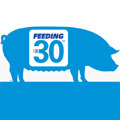 A sow’s reproductive success and longevity potential are often measured through her body condition score (BCS). Proper body condition can impact short-term production and long-term profitability potential, so feeding sows to maintain adequate BCS through all production stages is an important part of an operation’s success.
A sow’s reproductive success and longevity potential are often measured through her body condition score (BCS). Proper body condition can impact short-term production and long-term profitability potential, so feeding sows to maintain adequate BCS through all production stages is an important part of an operation’s success.
“A sow’s body condition score is an indicator of her current productivity potential and a forecast of her future,” says Gawain Willis, director of nutrition services for Purina Animal Nutrition LLC. “Gestating sows should be fed to maintain a BCS of 3 on a 5-point scale. Maintaining this BCS through all production stages is ideal.”

The sow should be fed so she is at a BCS of 3.0 at farrowing. Sows that farrow with adequate body condition have a greater potential to produce larger birth weights in the litter, greater milk production and a shorter return to estrus post-weaning.
An ideal BCS at farrowing begins during gestation. Producers can help sows to regain body condition from the last litter early in gestation and then provide nutrients to keep BCS steady through farrowing. If sows are bump-fed in late gestation, producers are encouraged to allow for extra weight gain and condition prior to farrowing by feeding for less condition in early gestation.
Temperature also plays a role in BCS. During the winter, additional feed may be needed to support the sow’s extra nutrient demand for body heat. Industry recommendations show that up to an additional 2,500 kilocalories of metabolizable energy per head per day may be needed to promote consistent BCS through winter.
On the flip side, less energy may be required during warmer periods. Overfeeding sows during gestation may result in over-conditioned sows entering the farrowing facility. These sows have a higher probability for farrowing difficulties and excessive weight loss in lactation.
To ensure that sows are in the proper condition, producers are encouraged to body condition score sows on a regular basis.
“Sows should be scored at least quarterly,” Willis recommends. “If sows are under- or over-conditioned, ration and management changes can be made to keep condition consistent. To promote consistency, employees should be trained and a standardized scoring practice should be followed.”
Another indicator of condition during gestation is weight gain. Research from North Carolina State University states that a sow should ideally gain 75 to 100 pounds and a gilt should gain 100 to 125 pounds during gestation.
This condition is required by the female after farrowing – helping her to not quickly lose body condition when nutrient requirements increase. Because lactating sows produce 15 to 25 pounds of milk per day, daily nutrient requirements are nearly three times higher in lactation than during gestation.
“Nutrient demands on lactating sows grow as sows in the U.S. continue to produce historically large litters,” Willis says. “If sows are not fed properly in gestation and lactation to support these litters, nutrients will be drawn from the sow’s body reserves and her body condition will be sacrificed. Over-conditioned sows may lose extra weight quickly and under-conditioned sows can fall to an even lower BCS.”
Research from the University of Minnesota shows that excessive body weight loss during lactation can lead to future problems including an extended weaning-to-estrus interval, smaller subsequent litter sizes and lower conception rates. The researchers also found greater probability for bone and spine issues as minerals are mobilized from bones during lactation of over- or under-conditioned sows.
“Well-conditioned sows are our best bet for reaching 30 pigs per sow per year,” Willis says. “To meet the industry goal, we need to provide the nutrients that our sows require. Without adequate nutrients to care for larger litters, parity levels could suffer.
“On the other hand, the proper level of nutrients during each maternal stage can position the litter and the sow to reach their full potential,” Willis adds. “Success with sows often begins with a proper ration and a consistent body condition scoring program.”
For more information, contact Gawain Willis at (636) 742-6154 or email: gmwillis@landolakes.com.

Swine producers, veterinarians and nutritionists can learn more about the Feeding for 30TM Program and access nutritional resources by visiting www.Feedingfor30.com or www.facebook.com/Feedingfor30.
Purina Animal Nutrition LLC (www.purinamills.com) is a national organization serving producers, animal owners and their families through more than 4,700 local cooperatives, independent dealers and other large retailers across the United States. Driven by an uncompromising commitment to animal excellence, Purina Animal Nutrition is an industry innovator, offering America's leading brands of complete feeds, supplements, premixes, ingredients and specialty technologies for the livestock and lifestyle animal markets. Headquartered in Shoreview, Minn., Purina Animal Nutrition LLC is a wholly owned subsidiary of Land O’Lakes, Inc.
Because of factors outside of Purina Animal Nutrition LLC’s control, individual results to be obtained, including but not limited to: financial performance, animal condition, health or performance cannot be predicted or guaranteed by Purina Animal Nutrition LLC.
March 22, 2013 - Feeding for 30


